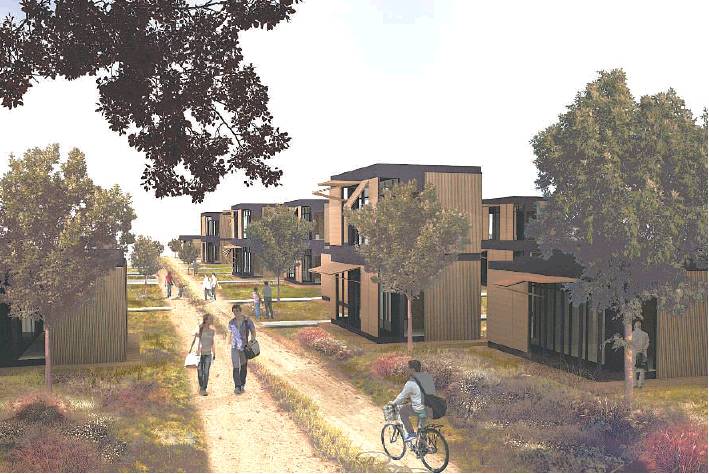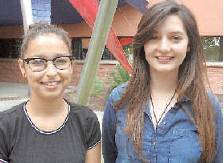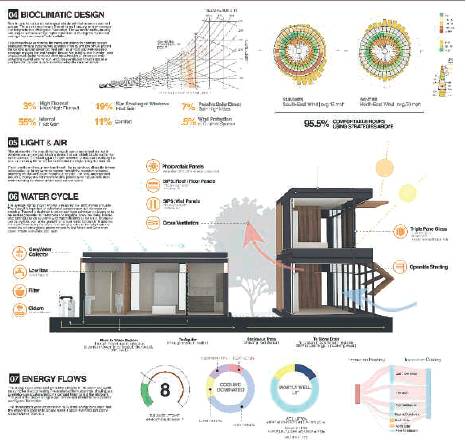‘HOUSING A MILLION’
AIA honors UTSA student project
By Steve Bennett STAFF WRITER
With San Antonio’s population projected to grow by 1.1 million over the next quarter century, increasing the city’s population to 2.4 million by 2040, we’re going to need a lot more housing — most experts predict at least 500,000 units.
How will we build it affordably? How will that kind of large-scale construction effort affect the environment? Where, in a nutshell, are we going to put everybody?
Two architecture students at the University of Texas at San Antonio have what they think is at least a partial solution.
The American Institute of Architects agreed. The national trade association recognized Estefania Barajas, 23, and Jorden Gomez, 21, for their design proposal, called “Housing a Million,” which envisions “micro-houses” in people’s backyards.
The AIA’s Committee on the Envirnoment, in partnership with the Association of Collegiate Schools of Architecture, placed “Housing a Million” among the top 10 projects in a competition that challenged students to design sustainable infill urban housing. Gomez and Barajas emerged from a field of more than 600 participants from 38 schools in the United States and Canada.
They were recognized at the AIA convention in April, and their project will be exhibited at the architecture school association’s annual meeting in March 2018. It’s the second year in a row that UTSA has placed an architectural project in the top
10.
“This is a major competition,” said Ian Caine, an assistant professor at UTSA’s College of Architecture. “It was the only project from Texas. This proposal was so important because at current densities, the city’s population growth will expand beyond its infrastructure at an alarming rate, so the students had to take into account where to put 1.1 million people. Architects can’t just design in a vacuum. Every line you draw has some impact.”
With assistant professor Rahman Azari, Caine designed the “San Antonio 2040” UTSA studio course — a two-pronged laboratory combining building performance (how a building uses energy) and architectural design — which was the incubator for “Housing a Million.”
Gomez and Barajas were all smiles during a recent interview, but they grew serious when they talked about “Housing a Million.”
“Yes, we are putting housing in people’s backyards,” said Barajas, who is from Laredo, with roots in Querétero, Mexico, and will graduate later this year. “We are trying to densify one urban block.”
The proposal places micro-units — each featuring a small studio apartment with a bedroom, kitchen and bathroom — in the backyards of existing homes in a block in south San Antonio, transforming little used space into a new community featuring shared space, parking, bioswales and walkways.
“The alley becomes a main thoroughfare, while the street remains untouched,” Caine said. “The single family home will continue to dominate the street, while family housing dominates the alley, so they have effectively flipped the equation.”
Expanding the plan — up to six homes per backyard — to block after block, it would create a dense urban neighborhood and limit the city’s overall footprint growth, which in turn saves energy.
The students believe that their micro-unit proposal could accommodate 10 percent of San Antonio’s projected population growth, or about 50,000 people.
The small homes would be constructed of load-bearing SIPs, or modular Structural Insulated Panels, offering quick, low-cost installation.
“As we researched, the more the design would change,” said Gomez, who’s from El Paso and just graduated. “And we realized the houses could be put in kits, so they could be built quickly, easily and cheaply on site.”
Clad in Western red cedar, the rectangular micro-units, with slightly pitched roofs, are modular and minimalist. Other sustainability factors in each kit would include a water collector system, photovoltaic panels and a native planting scheme.
“This process challenges the students to think holistically about architectural design,” Azari said, “considering such issues as community density and energy usage. They must know the synergies and trade-offs from these various design issues.”
Working on the “Housing a Million” project in the UTSA studio has had a tremendous impact on the students’ thinking, Gomez said.
“This process has really changed the way I will think about design in the future,” she said. “It’s not just about the way it looks, but the way it performs.” sbennett@express-news.net


